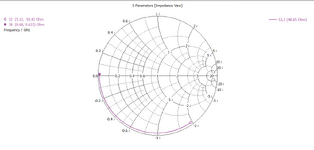yefj
Advanced Member level 5

Hello,Shown below a ring quadrature coupler i have built.
However one critical problem is that from the diagram bellow i need the isolation port to be matched .
In theory i need to put 50Ohm termination to this port .
However i dont trust is 30GHz to put resistors because they can cause problems when i will solder them.
Is there a trick in transmission line theory that i can use to make a 50Ohm termination for my isolation?
Thanks.


However one critical problem is that from the diagram bellow i need the isolation port to be matched .
In theory i need to put 50Ohm termination to this port .
However i dont trust is 30GHz to put resistors because they can cause problems when i will solder them.
Is there a trick in transmission line theory that i can use to make a 50Ohm termination for my isolation?
Thanks.



